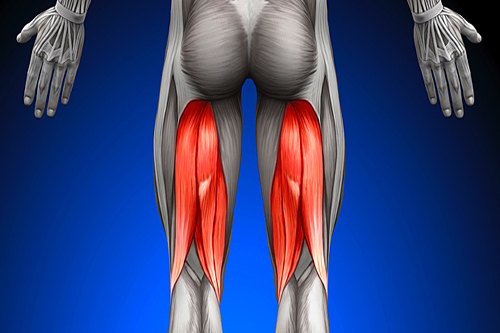
If you are an athlete, particularly in a sport with significant amounts of high-speed running, it would not be unlikely that you have suffered an injury to your hamstrings. If you have experienced a hamstring injury, it is also not unlikely to have injured it twice or even multiple times. It likely stopped you in your tracks and left you on the ground in pain. What and where are the hamstrings, and why is this such a common injury among athletes?
The hamstrings are a group of 3 muscles on the back side of your thigh. This group of muscles assist in extending the hip back and flexing the knee in a bent position. They are important muscles used in all sports but are at greater risk for injury in running type sports like soccer, football, and track/cross country. This is because a great amount of force is required from the muscles when they are in a stretched position (sprinting, hurdles, kicking, changing direction, etc.), and therefore could result in a hamstring strain if the muscle is weak, fatigued, or not warmed up properly. Other factors that could contribute to a hamstring strain include tightness of the muscles in the front of the hip and quad, putting the hamstring on greater stretch. Weak glute muscles can contribute as well. The glutes and the hamstrings work together, and if the glutes are weak, it can cause the hamstrings to carry a greater load required of both muscle groups and can become overworked as a result.
You likely will feel and know when you have injured or strained your hamstring, no matter the severity. It will likely cause you to quit play of whatever activity or sport you are participating in. Muscle strains typically fall into one of three grades of severity:
- Grade 1 is a mild tear/strain that likely will feel like a pulled or cramping muscle and may not cause too much pain. With a grade 1 strain you may only feel the pain for a few days.
- Grade 2 is a moderate tear that will feel more intense like a burning or stinging pain and will last longer than a couple of days.
- Grade 3 is the most severe level, which results in a complete tear of the muscle. You will feel a greater intensity of pain that likely will keep you from being able to walk or move like you normally would. Pain from a grade 3 strain could last weeks and may even require imaging and further diagnostics from an orthopedic doctor to determine if surgery is necessary to repair the injured area.
Immediately following your injury it is best to rest the hamstrings from activities or sports that cause further pain or irritation. This may even include walking, and crutches may be necessary to avoid further overstress to the area. Icing 15-20 minutes for 3-4 times a day is also important immediately following your injury. Alongside acute care to your injured tissue, physical therapy can help tremendously to rehab your hamstring back to full function. When you go to see your physical therapist for your initial evaluation, they will gather health history information, perform tests, and take measurements that will diagnose and determine what type of care is needed for you specifically. They will write up a treatment plan of care for you to reach your goals.
In your follow-up physical therapy sessions you could expect hands-on manual therapy techniques to decrease pain and improve flexibly and quality of muscle tissue and use. They will prescribe a strengthening and range of motion therapeutic exercise program that is safe and specific to your needs. They will also provide training and education regarding correct and quality movement patterns for safe return to full function and play.
It would be wise to stretch and strengthen your hamstrings as a preventative measure, as well as always warming up properly prior to athletic or sport involvement. If you are starting a new sport or fitness activity, slowly work into it. Listen to your body and gradually increase frequency and intensity as tolerable and appropriate for your body to adapt to the new movement patterns. Those that have had a hamstring injury or strain are 2 to 6 times more likely to injure it again, so be mindful and take care of your hamstrings!


